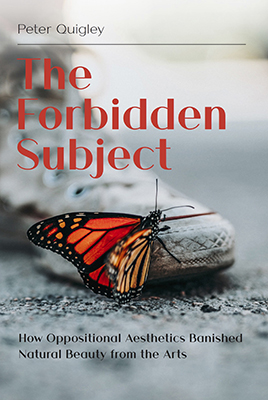The Forbidden Subject
How Oppositional Aesthetics Banished Natural Beauty from the Arts

Peter Quigley
‘WE ARE FOOLS TO TURN FROM THE SUPERHUMAN BEAUTY’*
The Forbidden Subject launches from Ed Abbey’s affirmation in Desert Solitaire: ‘This is the most beautiful place on earth’. How could such a sentiment become construed as problematic, elitist, or worse? How was a calculated and intentional attack on beauty sustained for more than a century? How did beauty become, and why does it largely remain, what Emory Elliot dubbed ‘the forbidden subject’? This book reviews the devastating impacts modernist avant-garde, Marxism, some feminisms and postmodernism have enacted – through paranoia, blame, cynicism – on beauty, hope and desire. Oppositional epistemologies deliberately eviscerated the possibilities and standing of beauty in criticism as well as in lived experience. According to Myra Jehlen, the orthodox critic thus became ‘an adversary of the work he or she analyses’, tasked with undoing the aesthetic deception of what was read to ‘expose its misrepresentations and false ideals, to strip away the lie and expose the liar’. Tracing the war on natural beauty through the literary and visual arts, The Forbidden Subject asks what it has meant for the humanities, for problem solving environmental issues, for educating students, for our personal lives and, more recently, for ecocriticism. The book asks if current ecocriticism has been misdirected by the corrosive weight of negativity – the requirement always to be ‘reading against’ – that has persisted in the arts and humanities for decades. It rehearses why a ‘return to beauty’ was imperative, and what has happened to that return since the turn of the twenty-first century. Pondering these questions, The Forbidden Subject intertwines the potential place and nature of beauty and the beauty of nature and place, concluding with a substantial reading of the poetry and thought of Robinson Jeffers.
*Jeffers
LOOK INSIDE THIS BOOK at Amazon.co.uk
‘brave and heartfelt, well-researched and persistently energetic’
Whitney Hoth – Jeffers Studies
‘a lively and provocative contribution’
David Copland Morris – Western American Literature
THE AUTHOR
Peter Quigley is associate Vice President of academics for the UH system and Professor of English at the University of Hawaii, Manoa. His recent books are Housing the Environmental Imagination: Beauty, Politics and Refuge in American Nature Writing and Ecocritical Aesthetics: Language, Beauty, and the Environment (ed. with Scott Slovic). He has worked in ecocritical studies since the mid 1980s and has a long-time interest in the life and work of Robinson Jeffers, having been President of the Jeffers Association for several years. He works on O’ahu, Hawai’i but lives part-time on the Big Island – situated near the ocean and on the world’s most active volcano – with his wife, sons and Golden Retrievers.
CONTENTS
1. ‘Steel Flowers for the Bride’: The Emergence and Cooptation of Natural Beauty in the Twentieth and Twenty-first Centuries
2. Modernism, Beauty and the Permanent Avant Garde
3. Marxism and Neo-Marxist Aesthetics: Plotting the ‘Failure of the Present’
4. Ecocriticism and the Abdication of Hope and Beauty: ‘I have to believe there’s a way we can get out of this mess’
5. The Return of the Repressed: Beauty’s Re-emergence
Index
Publication date, 22 July 2019
ISBN 978-1-912186-09-9 (HB) £65. 260 pp.
